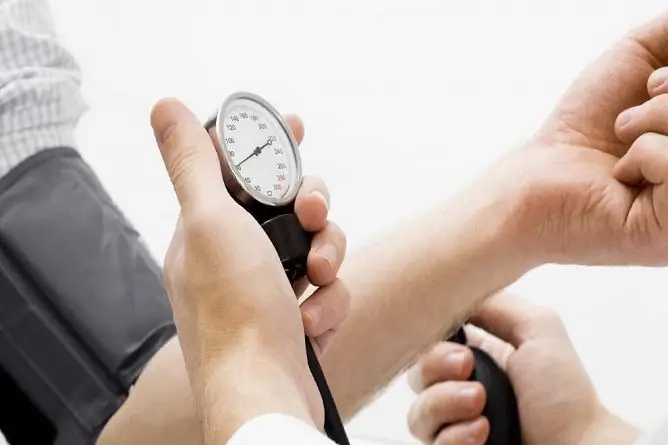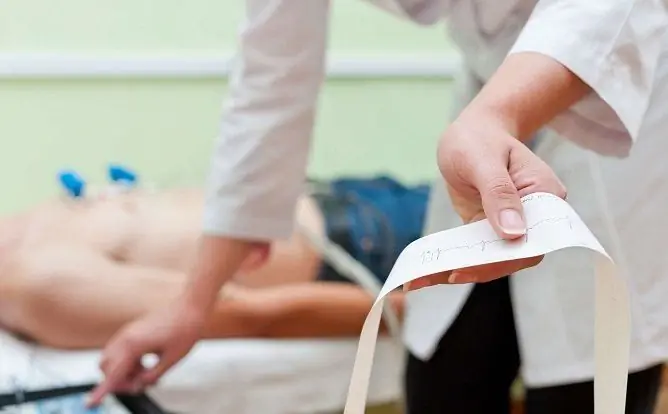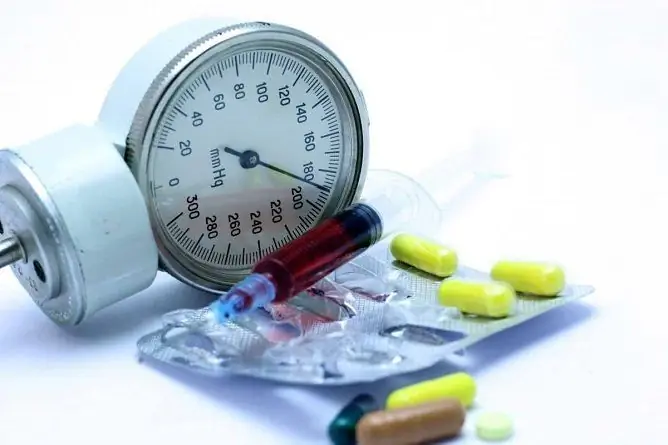- Author Rachel Wainwright [email protected].
- Public 2023-12-15 07:39.
- Last modified 2025-11-02 20:14.
The hormone estradiol: functions, determination of blood levels and correction
The content of the article:
- Norm
- Biological role
- Causes of high and low hormone levels
- Test for estradiol
- Correction of blood hormone levels
Estradiol is the main female sex hormone belonging to the estrogen group. He is responsible not only for the reproductive, but also the general health of the woman. It is produced mainly by the follicular apparatus of the ovaries, as well as in a small amount by the adrenal cortex, during pregnancy it is secreted by the placenta.

Estradiol is the main hormone of the estrogen group, female sex hormones
The female hormone is also present in men, but its concentration is much lower than in women. In the male body, the secretion of the hormone occurs in the testes and adrenal cortex. In addition, it is formed in peripheral tissues from androgens (androstenedione, testosterone) under the influence of the P450-aromatase enzyme.
Norm
Normal estradiol levels in men range from 40 to 161 pmol / L. In women, the indicators of the norm differ on different days of the menstrual cycle, and this should be taken into account when analyzing blood for estradiol:
- days of menstrual bleeding (follicular phase) - from 68 to 1,269 pmol / l;
- ovulatory phase - from 131 to 1,655 pmol / l;
- yellow phase (luteal) - from 91 to 861 pmol / l;
- postmenopause - less than 73 pmol / l.
The hormone rates during pregnancy differ depending on the gestational age:
- 9-12 weeks - from 1,030 to 2,210 pmol / l;
- 13-16 weeks - from 2,000 to 4,400 pmol / l;
- 17-20 weeks - from 3 300 to 7 700 pmol / l;
- 21-24 weeks - from 5,100 to 11,300 pmol / l;
- 25-28 weeks - from 7,100 to 14,900 pmol / l;
- 29-32 weeks - from 7,900 to 14,900 pmol / l;
- 33-36 weeks - from 9 400 to 22 600 pmol / l;
- 37-38 weeks - from 12 300 to 23 700 pmol / l;
- 39-40 weeks - from 8 300 to 26 600 pmol / l.
Biological role
Estradiol, like all estrogens, has a feminizing effect on a woman's body. It stimulates:
- development of genitals (vagina, uterus and fallopian tubes);
- development of ducts and stroma of the mammary glands;
- pigmentation of the genitals and nipples;
- the formation of secondary female sexual characteristics;
- processes of growth and closure of the epiphyses (growth zones) of long tubular bones;
- rejection of the endometrium and the onset of menstrual bleeding;
- synthesis in the liver of vitamin K-dependent blood coagulation factors (II, VII, IX, X).
In addition, the hormone affects the exchange of copper and iron. It has an anti-sclerotic effect, reducing the content of low density lipoproteins in the blood and increasing the content of high density lipoproteins.
The biological significance of the hormone estradiol in the body in men remains unclear. Its participation in spermatogenesis, mineral and gas metabolism is assumed.
Causes of high and low hormone levels
An increase in the level of the hormone in the blood in women can be observed in the following cases:
- follicular ovarian cyst;
- follicle persistence;
- estrogen-producing tumors of the uterus or ovaries;
- genital endometriosis;
- obesity;
- diseases of the thyroid gland;
- cirrhosis of the liver.
Taking some medications can also lead to an excess of the hormone:
- oral contraceptives;
- anabolic steroid;
- valproic acid;
- carbamazepine;
- nafarelin;
- phenytoin;
- troleandomycin;
- mifepristone;
- cimetidine;
- clomiphene.
A lowered hormone level indicates the possible presence of the following pathologies:
- inflammatory diseases of the genital organs;
- the threat of termination of pregnancy;
- delayed sexual development;
- dysfunction of the pituitary gland;
- increased prolactin;
- alcohol addiction.
If a woman smokes a lot or is actively involved in sports, does not eat well (vegetarianism, the predominance of carbohydrates in the diet and restriction of animal fats), this can also cause low levels of the hormone. In addition, therapy with certain drugs (octreotide, pravastatin, epostan, cyproterone, nandrolone, moclobemide, megestrol, buserelin, dexamethasone) leads to a reduced concentration of the hormone.
Test for estradiol
Determination of the content of the hormone in the blood should be assigned in the following situations:
- the threat of spontaneous abortion;
- pathology of the placenta;
- delayed or premature puberty;
- suspicion of tumors of the uterus or ovary;
- dysfunctional uterine bleeding;
- premenstrual syndrome;
- osteoporosis;
- climacteric syndrome;
- menstrual irregularities.
In some cases, it becomes necessary to find out what the level of the hormone in men, for example, with the development of gynecomastia - a pathological condition characterized by an increase in the mammary glands.
The concentration of the hormone in the blood is influenced by various factors (physical activity, smoking, drinking alcohol, inaccuracies in the diet, etc.). This means that in order to obtain an accurate result, their influence should be excluded. For this purpose, two days before the analysis, it is necessary to stop smoking, drinking alcoholic beverages and fatty foods, having sex, and excluding heavy physical activity.

Deviations in the content of estradiol in women may indicate tumors
Determination of the hormone level is usually carried out on the 3-5th day of the menstrual cycle. If necessary, the study can be scheduled for 21 days of the cycle. Blood sampling is carried out in the morning, on an empty stomach.
Correction of blood hormone levels
A deviation in the content of the hormone in the blood of a woman is subject to treatment by a gynecologist-endocrinologist.
Considering that the concentration of the hormone increases against the background of oncological diseases of the genital area, a thorough examination is shown aimed at identifying a possible tumor, which includes the following methods:
- Ultrasound of the pelvic organs;
- magnetic resonance imaging or computed tomography;
- blood for tumor markers.
Patients in the climacteric period for 2-3 months are prescribed, according to the contraceptive scheme, drugs containing estradiol (Ovestin, Estriol).
With artificial menopause caused by the removal of the ovaries, as well as severe premenstrual syndrome, combined oral contraceptives are shown, which include estrogens and progestogens.
With post-term pregnancy, labor is stimulated (Estrofem, Proginova).
Treatment of delayed puberty associated with estrogen deficiency includes the appointment of estradiol preparations for three weeks. This is followed by a week break, and the course is repeated. Hormone therapy in this case should be carried out for at least six months.
YouTube video related to the article:

Elena Minkina Doctor anesthesiologist-resuscitator About the author
Education: graduated from the Tashkent State Medical Institute, specializing in general medicine in 1991. Repeatedly passed refresher courses.
Work experience: anesthesiologist-resuscitator of the city maternity complex, resuscitator of the hemodialysis department.
Found a mistake in the text? Select it and press Ctrl + Enter.






